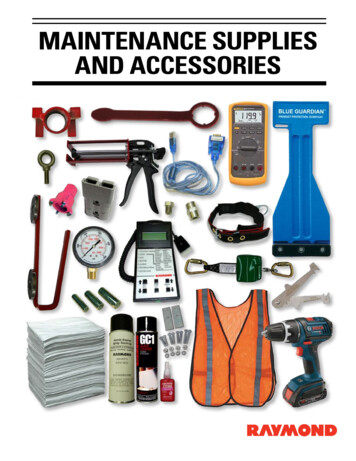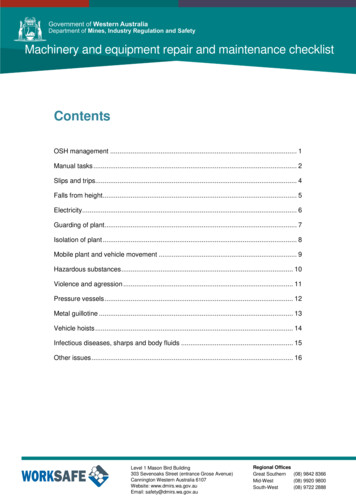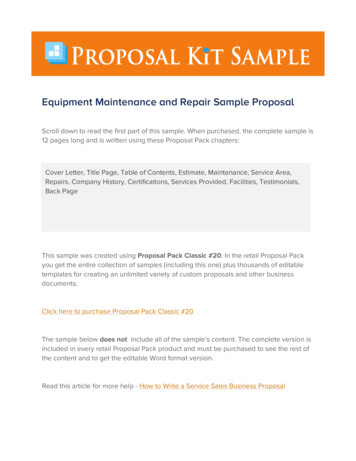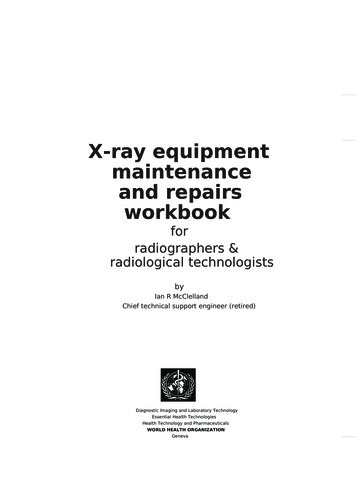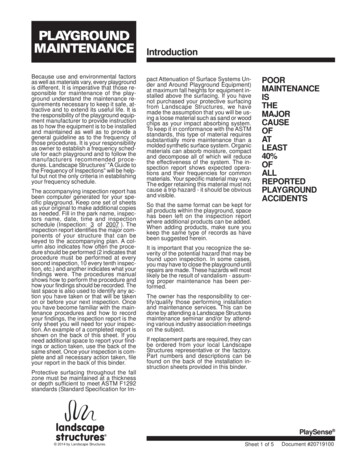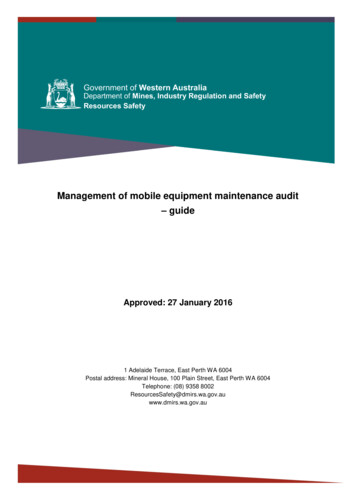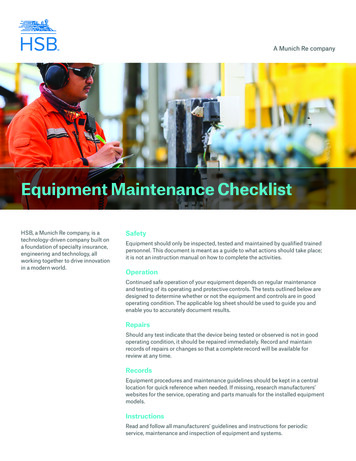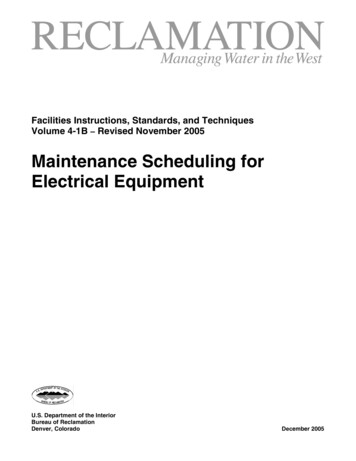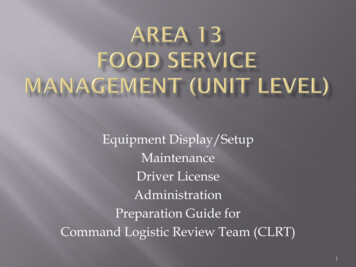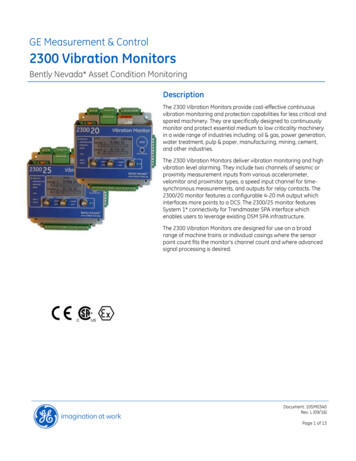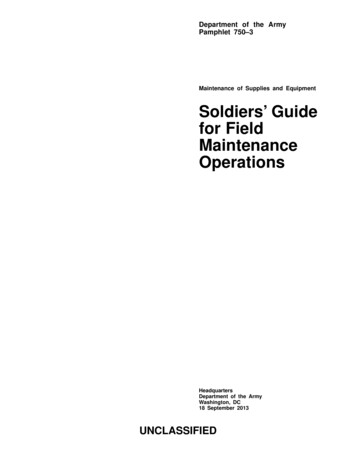
Transcription
Department of the ArmyPamphlet 750–3Maintenance of Supplies and EquipmentSoldiers’ Guidefor FieldMaintenanceOperationsHeadquartersDepartment of the ArmyWashington, DC18 September 2013UNCLASSIFIED
SUMMARY of CHANGEDA PAM 750–3Soldiers’ Guide for Field Maintenance OperationsThis major revision, dated 18 September 2013-oAdds various maintenance levels of use for field maintenance operations (para1-4).oRevises routing procedures for submitting DA Form 5988-E (para 3-2c(6)).oRevises maintenance of scheduled service forms (para 3-2d(1)).oUpdates publication account holder responsibilities (para 3-5d).oIdentifies additional duties for the readiness division officer in charge ofsupport operations sections (para 4-14e).oUpdates modification work order procedures (para 7-2a(6)).oAdds left behind equipment guidance (chap 8).oAdds RESET guidance (chap 9).oAdds predeployment training equipment (chap 10).oAdds non standard equipment guidance (chap 11).oReplaces Combat Service Support Automation Management Office withSustainment Automated Support Management Office (throughout).oReplaces Unit Level Logistics System-Aviation System with Standard ArmyMaintenance System-Enhanced (throughout).oMakes administrative changes (throughout).
*Department of the ArmyPamphlet 750–3HeadquartersDepartment of the ArmyWashington, DC18 September 2013Maintenance of Supplies and EquipmentSoldiers’ Guide for Field Maintenance OperationsStates, and the U.S. Army Reserve unlessotherwise stated. During mobilization, theproponent may modify guidance and procedures contained in this publication.History. This publication is a majorrevision.Summary. This pamphlet describes procedures for field maintenance operations.Applicability. This pamphlet applies tothe Active Army, the Army NationalGuard/Army National Guard of the UnitedContentsProponent and exception authority.The proponent of this pamphlet is theDeputy Chief of Staff, G–4. The proponent has the authority to approve exceptions or waivers to this pamphlet that areconsistent with controlling law and regulations. The proponent may delegate thisapproval authority in writing, to a divisionchief within the proponent agency or itsdirect reporting unit or field operatingagency in the grade of colonel or the civilian equivalent. Activities may request awaiver to this pamphlet by providing justification that includes a full analysis ofthe expected benefits and must includeformal review by the activity’s seniorlegal officer. All waiver requests will beendorsed by the commander or seniorleader of the requesting activity and forwarded through their higher headquartersto the policy proponent. Refer to AR25–30 for specific guidance.Suggested improvements. Users areinvited to send comments and suggestedimprovements on DA Form 2028 (Recommended Changes to Publications andBlank Forms) directly to the Deputy Chiefof Staff, G–4 (DALO-MNF), 500 ArmyPentagon, Washington, DC 20310–0500.Distribution. This publication is available in electronic media only and is intended for command levels C, D, and Efor the Active Army, the Army NationalGuard/Army National Guard of the UnitedStates, and the U.S. Army Reserve.(Listed by paragraph and page number)Chapter 1Introduction, page 1Purpose 1–1, page 1References 1–2, page 1Explanation of abbreviations and special terms 1–3, page 1Maintenance levels 1–4, page 1Chapter 2Field Maintenance Standing Operating Procedures, page 1Army modular units 2–1, page 1Need for standing operating procedures 2–2, page 1Areas to address in standing operating procedures 2–3, page 2Motor pool and shop safety 2–4, page 3Sample maintenance standing operating procedure 2–5, page 3Chapter 3Essential Functional Areas within Field Maintenance, page 3Preventive maintenance checks and services 3–1, page 3The Army Maintenance Management System 3–2, page 3*This publication supersedes DA Pam 750–3, dated 29 September 2006.DA PAM 750–3 18 September 2013UNCLASSIFIEDi
Contents—ContinuedVehicle operators licensing 3–3, page 7Shop stock 3–4, page 7Publications 3–5, page 8Logistics information warehouse 3–6, page 8PS: The Preventive Maintenance Monthly 3–7, page 8Tools and test, measurement, and diagnostic equipment 3–8, page 9Tactical maintenance 3–9, page 9Battle damage assessment, repair, and recovery 3–10, page 9Chapter 4Field Maintenance Personnel, page 10Maintenance managers 4–1, page 10Maintenance standards 4–2, page 12Guidance for Soldiers 4–3, page 12Points for emphasis 4–4, page 12Operators and crews 4–5, page 13Supervisors 4–6, page 13Maintenance Soldiers and other support personnel 4–7, page 14Forward support company maintenance platoon headquarters 4–8, page 14Maintenance control officer 4–9, page 14Maintenance platoon leader 4–10, page 15Maintenance technician 4–11, page 15Maintenance control supervisor 4–12, page 15Brigade support battalion field maintenance company operations 4–13, page 16Support operation’s readiness division officer in charge 4–14, page 16Chapter 5Unit Considerations, page 16Section ITraining, page 16Training programs 5–1, page 16External challenges 5–2, page 17Internal challenges 5–3, page 17What the operator or supervisor and leader knows 5–4, page 17Commanders’ maintenance training 5–5, page 17Vehicle operator licensing 5–6, page 17Receipt of equipment 5–7, page 18Section IIMotor Pool Security, page 18General information 5–8, page 18Garrison considerations 5–9, page 18Chapter 6Recognition of Drivers, Operators, and Mechanics, page 18Driver and mechanic badges 6–1, page 18Unit Driver Badge Program 6–2, page 19Special Operator Badge 6–3, page 19Mechanic Badge 6–4, page 19Verification procedures 6–5, page 19Unit maintenance awards 6–6, page 20Army Award for Maintenance Excellence 6–7, page 20iiDA PAM 750–3 18 September 2013
Contents—ContinuedChapter 7Maintenance Control Functions, page 20Overview 7–1, page 20Technical inspections 7–2, page 20Estimated and actual costs of damage 7–3, page 21Combat losses 7–4, page 21Maintenance expenditure limits 7–5, page 21Establishing maintenance priorities 7–6, page 22Modification work order 7–7, page 22Commercial off-the-shelf items 7–8, page 22Information technology warranties 7–9, page 23Non information technology warranties 7–10, page 24Ground equipment usage reporting 7–11, page 24Chapter 8Left Behind Equipment, page 24General guidance 8–1, page 24Equipment low usage programs 8–2, page 25Left behind equipment aircraft sustainment 8–3, page 26Chapter 9Equipment RESET, page 26General guidance 9–1, page 26Automated Reset Management Tool 9–2, page 27Chapter 10Pre-Deployment Training Equipment, page 27General guidance 10–1, page 27Pre-deployment training equipment maintenance 10–2, page 27Chapter 11Tactical Non-Standard Equipment Maintenance and Sustainment, page 28General guidance 11–1, page 28Non-standard equipment maintenance 11–2, page 28Non-standard equipment inspection and repair 11–3, page 28Non-standard equipment contractor logistics support 11–4, page 28Non-Standard Equipment Army Warranty Program 11–5, page 29AppendixesA.References, page 30B.Sample Maintenance Standing Operating Procedures, page 34Table ListTable 4–1: Elements of the Army Maintenance Standard, page 13Figure ListFigure 3–1: Equipment dispatch flowchart, page 5Figure 4–1: Field-level maintenance management structures, page 11GlossaryDA PAM 750–3 18 September 2013iii
Chapter 1Introduction1–1. Purposea. This pamphlet provides information needed for field maintenance operations. It does not replace other publications. Instead, this pamphlet takes the applicable maintenance regulations and provides a single go-to reference for fieldmaintenance operations. It applies to all Army equipment except installation equipment (see AR 420–1 and technicalmanual (TM) 5–600 series), industrial production equipment, and nonstandard equipment that is locally purchased andhas not been type-classified or assigned a national stock number (NSN) (however, non-tactical (commercial) wheeledvehicles are covered by this pamphlet), equipment procured with non-appropriated funds, and medical equipmentcovered by AR 40–61.b. The guidance found in this pamphlet can be applied to any field maintenance operation, regardless of the densityof equipment, or if field maintenance support is organic in direct support or attached from a forward support company(FSC) or received on an area support basis at echelons above brigade (EAB) level.1–2. ReferencesRequired related publications and prescribed referenced forms are listed in appendix A.1–3. Explanation of abbreviations and special termsAbbreviations and special terms used in this pamphlet are explained in the glossary.1–4. Maintenance levelsa. The Army Maintenance System, less aircraft, is a two-level system that consists of field and sustainment. Eachunique level makes a different contribution to the overall system.b. The field-level maintenance—(1) Is generally characterized by on-(near) system maintenance, often utilizing line replaceable units (LRUs) andcomponent replacement, in the owning unit, using tools and test equipment found in the unit.(2) Is not limited to simply “remove and replace actions,” but it also allows for repair of components or end itemson-(near) systems. Field maintenance also includes adjustments, alignments, services, applying approved field-levelmodification work orders (MWOs), faults and failure diagnoses, battle damage assessment, repair, and recovery.(3) Always repairs and returns equipment to the user, and includes maintenance actions able to be performed byoperators.c. The sustainment-level maintenance—(1) Is generally characterized by "off system” component repair or end item repair and return to the supply system,or by exception, back to the owning unit. It is performed by national-level maintenance providers (including the ArmyMateriel Command (AMC) and installation director of logistics (DOL) maintenance activities).(2) Can be employed at any point in the integrated logistics chain. The intent of this level is to perform commodityoriented repairs on all supported items to return them to a national standard, provide a consistent and measureable levelof reliability, and to execute maintenance actions not able to be performed at the field-level of maintenance.Chapter 2Field Maintenance Standing Operating Procedures2–1. Army modular unitsThis publication updates guidance and procedures after force structure designs to the Army Modular Force. Thetransition from Army of Excellence and, in some cases, Force XXI, into the Army Modular Force has changed theArmy from a division-focused organization to a brigade-centric force. Prior to this conversion, divisions had uniquebrigades including airborne, air assault, heavy, mechanized, and light infantry, as well as the Force XXI and limitedForce XXI designs. Army force managers designed each division headquarters and their respective capabilities by thefew brigades they would command and control. The Army Modular Force, however, standardizes the design of divisionheadquarters and gives them the capability to have battle command of any type of brigade in the Army inventory. Thisnecessitates standardizing procedures to achieve interoperability. When operational command of a unit is transferred toa new division, the receiving division G–4 must transmit any unique requirements to the incoming organization.2–2. Need for standing operating proceduresAll units performing maintenance are required to have a maintenance standing operating procedures (SOP) signed bythe unit commander per AR 750–1. The maintenance SOP may be an annex to the unit’s SOP, an annex to the unit’slogistics SOP, or a stand-alone document. The purpose of the SOP is to formally describe the way a unit performsmaintenance on weapons, vehicles, communication equipment, chemical, biological, radiological and nuclear gear, andDA PAM 750–3 18 September 20131
other individual and unit equipment. The unit maintenance SOP will be written in enough detail to give recentlyassigned personnel, a firm grasp of how maintenance is to be accomplished in the unit. Personnel should have anopportunity to review it during in-processing.2–3. Areas to address in standing operating proceduresAs a minimum, the following areas of the SOP should be addressed in detail:a. Maintenance-related duties and responsibilities for key unit personnel.b. How the unit or FSC field maintenance platoon and section is organized.c. The Army Maintenance Management System (TAMMS) which addresses minor deviations or procedures notcovered in DA Pam 750–8 as follows:(1) Dispatch procedures for unit equipment.(2) Standard Army Maintenance System-Enhanced (SAMS-E), SAMS-E operations, and automation enablers asfollows:(a) Routine transaction and report requirements.(b) Connectivity (for example, very small aperture terminals and Combat Service Support Automated InformationSystems Interface).(c) Logistics information warehouse (LIW), DA Form 2408–9 (Equipment Control Record), requisition status, assetvisibility, usage verification, and publication listings.(d) The LIW (portion that was formerly Integrated Logistics Analysis Program (ILAP) requisition status).(e) MWO, Modification Management Information System (MMIS), safety of use (SOU) message, product qualitydeficiency report submissions online, and weapons data management online).(f) Quality control procedures for maintenance and dispatching equipment.(g) LIW (for example, unit Reset planner, including Automatic Reset Management Tool (ARMT) and ResetCommon Operating Picture (RCOP) tool).(3) Preventive maintenance checks and services (PMCS) as follows:(a) Procedures to be followed by personnel during scheduled field-level PMCS periods.(b) Procedures to be followed by all unit personnel associated with field-level PMCS checks and scheduled services.(c) Fault recordin
DA PAM 750–3 Soldiers’ Guide for Field Maintenance Operations This major revision, dated 18 September 2013--o Adds various maintenance levels of use for field maintenance operations (para 1-4). o Revises routing procedures for submitting DA Form 5988-E (para 3-2c(6)). o Revises maintenance of scheduled service forms (para 3-2 d(1)). o Updates publication account holder responsibilities .
